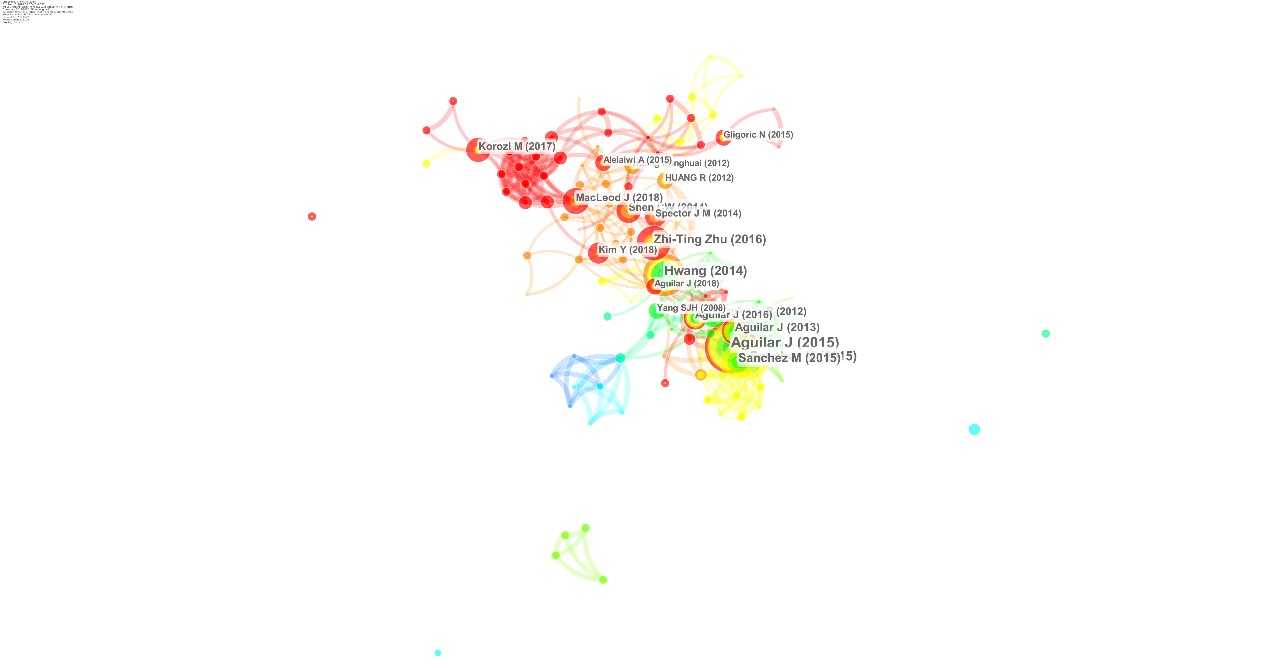 PDF(2491 KB)
PDF(2491 KB)


 PDF(2491 KB)
PDF(2491 KB)
 PDF(2491 KB)
PDF(2491 KB)
基于CiteSpace的国际智慧学习环境研究主题计量分析
Thematic Quantitative Analysis of International Smart Learning Environment Research Based on CiteSpace Software
[目的/意义]研究国际智慧学习环境领域起源与发展现状,为进一步完善智慧学习环境这一领域的相关研究实践提供了一定的参考。[方法/过程]以Web of Science数据库中搜集到的402篇文献为数据来源,借助文献计量工具CiteSpace软件对智慧学习环境领域的关键文献、机构、期刊、作者进行共现和共被引分析。[结果/结论]发现智慧学习环境源于技术发展下学习环境的改变,传统学习环境已经无法满足现代信息时代“原住民”的多样化需求,需要更新学习环境使学生学习更加高效便捷。同时,智慧学习环境强调以学生为中心,通过提高学习环境智慧化,使学生学习更加有效,因此不同的学者构建了许多智慧学习环境模型。目前,新型教学模式和评价体系与智能化跨媒体学习环境的构建是智慧学习环境领域未来发展的趋势之一。
[Purpose/Significance] In order to learn the origin and the development status of the international smart learning environment, It provides a certain reference for further improving the relevant research and practice in the field of intelligent learning environment. [Method/Process] This article used 402 documents collected in the Web of Science database as the data source, and analyzed the co-occurrence and co-citation analysis of key literatures, institutions, journals, and authors in the field of smart learning environment with the help of the bibliometric tool CiteSpace software. [Result/Conclusion] It is revealed that the smart learning environment stems from changes in the learning environment under technological development. The traditional learning environment can no longer meet the diverse needs of the "indigenous people" in the modern information age. The learning environment needs to be updated to make students’ learning more efficient and convenient. At the same time, the smart learning environment emphasizes student-centeredness. By improving the wisdom of the learning environment, students can learn more effective. Therefore, different scholars have constructed many smart learning environment models. It is one of the future development trends to construct the new teaching models, the evaluation system, and the intelligent cross-media learning environment in the field of smart learning environment.

智慧学习环境 / 热点 / 知识图谱 / CiteSpace
smart learning environment / hot spot / knowledge mapping / CiteSpace
| [1] |
邓国民. 国际教育技术学研究知识图谱: 理论, 技术与实践应用[M]. 上海:复旦大学出版社有限公司, 2018.
|
| [2] |
AGUILAR J , VALDIVIEZO P, CORDERO J, et al. Conceptual design of a smart classroom based on multiagent systems[C]//Computer Engineering and Applied Computing(WorldComp).Proceedings on the International Conference on Artificial Intelligence (ICAI). Athens: Springer, 2015.
|
| [3] |
HWANG G J. Definition, framework and research issues of smart learning environments-a context-aware ubiquitous learning perspective[J]. Smart learning environments, 2014, 1(1):1-14.
|
| [4] |
AGUILAR J, VALDIVIEZO J C P. A smart learning environment based on cloud learning[J]. International journal of advanced information science and technology, 2015, 39: 39-52.
|
| [5] |
SANCHEZ M,AGUILAR J, CORDERO J, et al. Basic features of a reflective middleware for intelligent learning environment in the cloud(IECL)[C]//Asia-Pacific conference. computer aided system engineering. SanFrancisco:IEEE, 2015.
|
| [6] |
ZHU Z T, YU M H, RIEZEBOS P. A research framework of smart education[J]. Smart learning environments, 2016, 3(1): 1-17.
|
| [7] |
MIKULECKY P. Smart environments for smart learning[C]//Distance Learning in applied information(DIVAI). 2012th international scientific conference on distance learning in applied informatics. Nitra:IEEE, 2012.
|
| [8] |
CHEN C. CiteSpace II: detecting and visualizing emerging trends and transient patterns in scientific literature [J]. Journal of the American Society for Information Science and Technology, 2006, 57(3): 359-421.
|
| [9] |
AGUILAR J, BOLIVAR A R, HIDROBO F, et al. Sistemas multiagentes y sus aplicaciones en automatizaci on industrial[J]. Universidad de Los Andes, Merida, Venezuela, 2013, 21(4):6-19.
|
| [10] |
KIM Y, SOYATA T, BEHNAGH R F. Towards emotionally aware AI smart classroom: current issues and directions for engineering and education[J]. IEEE access, 2018, 6:5308-5331.
|
| [11] |
KOPER R. Conditions for effective smart learning environments[J]. Smart learning environments, 2014, 1(1):1-17.
|
| [12] |
CHIN K W. Smart learning environment model for secondary schools in Malaysia: an overview[EB/OL].[2011-10-10].http://www.apdip.net/projects/seminars/it-policy/cn/resources/kang-waichin/smartlearning-mimos.ppt.
|
| [13] |
HWANG G J, TSAI C C, YANG S J H. Criteria, strategies and research issues of context-aware ubiquitous learning[J]. Journal of educational technology & society, 2008, 11(2): 81-91.
|
| [14] |
黄荣怀, 杨俊锋, 胡永斌.从数字学习环境到智慧学习环境——学习环境的变革与趋势[J].开放教育研究, 2012, 18(1): 75-84.
|
| [15] |
XU D M, HUANG W W, WANG H, et al. Enhancing e-learning effectiveness using an intelligent agent-supported personalized virtual learning environment: an empirical investigation[J]. Information & management, 2014, 51(4):430-440.
|
| [16] |
DOOLEY J, CALLAGHAN V, HAGRAS H, et al. The intelligent classroom: beyond four walls[J]. Proceedings of the icampus workshop,2011, 22(1):457-468.
|
| [17] |
HSU C C, CHEN H C, SU Y N, et al. Developing a reading concentration monitoring system by applying an artificial bee colony algorithm to e-books in an intelligent classroom[J]. Sensors, 2012, 12(10): 14158-14178.
|
| [18] |
YANG F, LU X, CHEN Z, et al. An interactive design in smart classroom[C]//computer science and information engineering.Communications in Computer and Information Science.Berlin: Springer, 2011.
|
| [19] |
GLIGORIC N, UZELAC A, KRCO S, et al. Smart classroom system for detecting level of interest a lecture creates in a classroom[J]. Journal of ambient intelligence & smart environments, 2015, 7(2):271-284.
|
| [20] |
MARIA K, VASILIS E, GRIGOEIS A. S-CRETA: smart classroom real-time assistance[M]. Berlin: Springer, 2012:67-74.
|
| [21] |
HSU C C, CHEN H C, SU Y N, et al. Developing a reading concentration monitoring system by applying an artificial bee colony algorithm to e-books in an intelligent classroom[J]. Sensors, 2012, 12(10): 14158-14178.
|
| [22] |
潘荔霞, 徐文彬, 李世宝, 等. 基于声纹识别的研讨型智慧教室构建[J]. 实验技术与管理, 2018, 35(7): 245-250.
|
| [23] |
KIM S, SONG S M, YOON Y I. Smart learning services based on smart cloud computing[J]. Sensors, 2011, 11(8): 7835-7850.
|
| [24] |
ZHANG Q H, JI P. Research of smart classroom design based on big data[C]// International Society of Computer Science and Electronic Technology.2018 3rd international conference on education & education research. ShenZhen: Francis Academic Press, 2018.
|
| [25] |
邓国民, 阎婷. 面向智能时代的跨媒体学习方式,理论与资源环境——基于国际多媒体学习研究的启示 [J]. 远程教育杂志, 2019, 37(3): 63-71.
|
徐新斐:进行资料查找、数据分析和论文写作
邓国民:修改稿件并提出完善意见
/
| 〈 |
|
〉 |